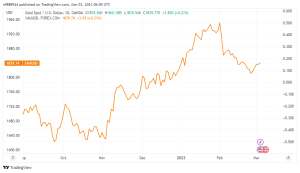After stalling its recovery mode, the day before, the gold(XAUUSD) price is making momentum for another run upward on Friday. The gold market is poised for its first weekly rise in five weeks.As the US Dollar (USD) has stopped its upward trend ahead of the high-impact US Services PMI report.
As traders assess aggressive Federal Reserve wagers, the US dollar falls in tandem with US Treasury bond rates.
On the last trading day, gold is back in the green, with fresh gains probable due to a decline in the US Dollar, as well as lower US Treasury bond rates throughout the curve. Investors ponder the likelihood of future US Federal Reserve (Fed) rate rises in the face of growing concerns about a ‘soft landing’ amid a mixed bag of economic data from the US. High inflation in the Eurozone and the United States pushed global inflation higher. In tandem, US Treasury rates reached multi-month highs, limiting the rise in the gold price. Yet, the benchmark 10-year US Treasury bond rates have fallen from four-month highs, reinvigorating gold bulls.
The United States ISM Services PMI is the next important indicator for gold traders to monitor.
The focus now shifts to the US ISM Services PMI data for February, which is due later in the North American session, for a fresh take on Fed expectations, especially after Atlanta Fed President Raphael Bostic stated that “slow and steady is going to be the appropriate course of action,” taking the wind out of the US Dollar’s rebound.
The headline US Services PMI is expected to fall to 54.5 from 55.2 previously. Likewise, the ISM Services Prices Paid (Feb) is expected to fall considerably to 64.5 from 67.8 in January.
Gold(XAUUSD) Technical Analysis
Gold(XAUUSD) buyers appear to have recovered their footing early Friday, allowing the price of gold to return to the weekly high of $1,844.
The bearish 21-Daily Moving Average (DMA) coincides with that level, giving it a strong barrier. Gold bulls are hoping for a daily candlestick closing above the latter to lend further legs to the shining metal’s continued recovery.

Over the 21 DMA, more buying chances will emerge, fueling a surge towards the modestly bullish 50 DMA around $1,858.
It is worth noting that the falling wedge breakout, which was revealed earlier this week, is still in play. The negative 14-day Relative Strength Index (RSI) is still a source of concern for gold bulls.
If they do not find approval above the 21 DMA, the gold price will fall. might face strong selling pressure. For Gold sellers, the previous day’s low of $1,830 will be the first target, below which a test of the $1,820 round barrier is unavoidable.
The junction zone of the February 28 low and the rising 100 DMA between the $1,805-$1,801 price range might operate as a strong demand region further south.









